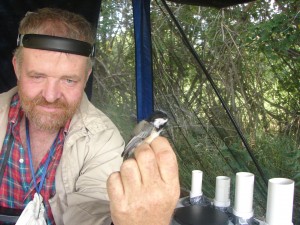Situated in the South Okanagan valley of British Columbia, Vaseux Lake is an important resting area for migrating birds. From August 1 to October 15, a bird banding station is in place to capture, record and release migrating and resident birds. There is a series of mist nests (8’ High by 30’ Long) which gently capture the birds. After being extracted from the nets the birds are taken to recording station where the Bander in Charge: identifies the species, attaches an appropriate sized metal band to a leg, determines the bird’s gender, measures the wing length, checks for molting and fat levels, and finally weighs each bird prior to release. The entire process from the start of a Net round (there are as many as 12 to 15 nets on the site) takes no longer than 30 to 40 minutes.
The data collected is recorded into a log and then transferred to an Excel spreadsheet and eventually into a data base where statistical and analytical work takes place.
During the successful 2012 season a total of just 1,293 birds were banded at this station. In addition for the first 2 weeks in October the station was in operation after dark to capture owls; which turned out to also be successful where 45 Northern Saw whet owls were banded.
Recent studies of the movement of North American bird species has turned up some alarming results, according to the National Audubon Society. The study took place over a period of many years and points to Global Warming as being a significant cause for increased stress and risk for many species. The study concludes that the ranges for many birds have been moving further northward into the Boreal Forest as the tradition breeding and wintering grounds have been either developed for human use or the wetlands have dried up.
If you are in the South Okanagan during August and September, the banding station welcomes visitors (if you would like more information please contact Great Horned Owl Eco Tours).
In the event that you find an injured or deceased bird with a band, you can report this to 1-800-327-2263 or www.reportband.gov




Hi Charlotte
It is amazing just how tiny some of the birds are, a Ruby Crowned Kinglet weighs in at 7 grams about the same weight as 2 pennies. Last year I extracted many birds from the mist nets including: Virginia rail, Northern Flickers, Gray Catbirds, Cassin’s Vireo and Tennessee Warbler. On the last day that I assisted I extracted a Green Wing Teal, the first one ever recorded at this station.
In 2009 I was there when a Prothonotary Warbler was caught. This bird’s range is east of the Mississippi River in the South Eastern US. Who knows how it ended up in British Columbia.
Working at a banding station is a good way to expand on’e knowledge about birds and contribute to the collection of data which is necessary to make inferences about species survival.
I got to band my first birds last August and it was so neat. I learned so much more about birds in the hand rather than watching them through binoculars.